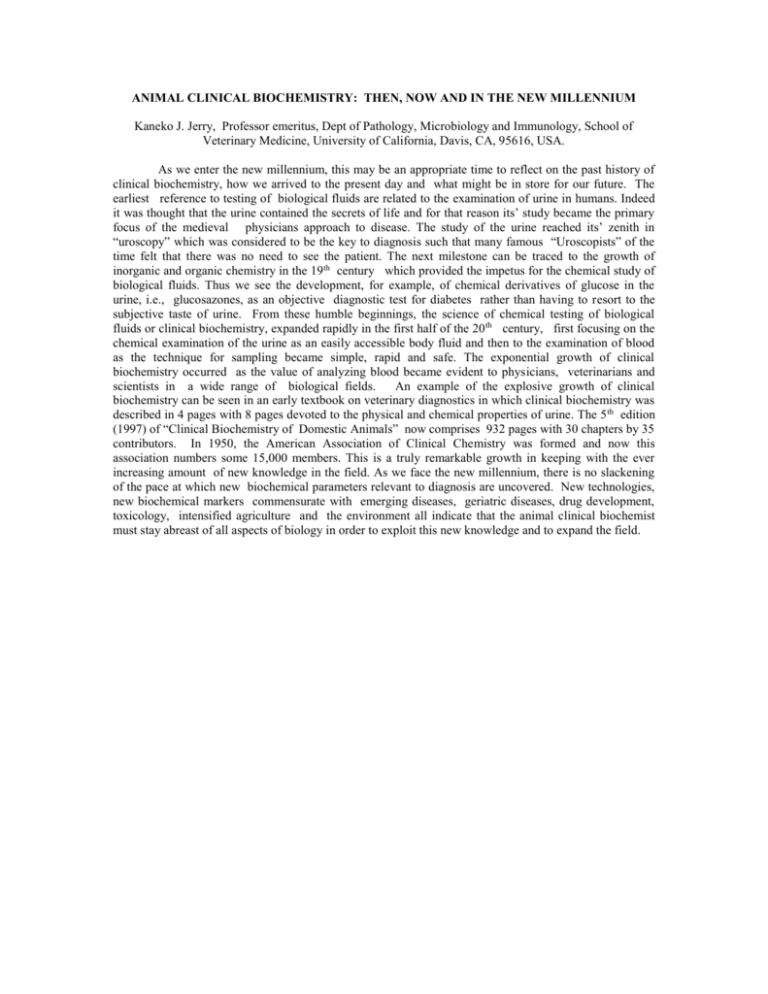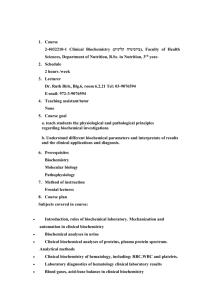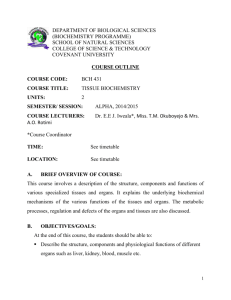ANIMAL CLINICAL BIOCHEMISTRY: THEN, NOW AND IN THE
advertisement

ANIMAL CLINICAL BIOCHEMISTRY: THEN, NOW AND IN THE NEW MILLENNIUM Kaneko J. Jerry, Professor emeritus, Dept of Pathology, Microbiology and Immunology, School of Veterinary Medicine, University of California, Davis, CA, 95616, USA. As we enter the new millennium, this may be an appropriate time to reflect on the past history of clinical biochemistry, how we arrived to the present day and what might be in store for our future. The earliest reference to testing of biological fluids are related to the examination of urine in humans. Indeed it was thought that the urine contained the secrets of life and for that reason its’ study became the primary focus of the medieval physicians approach to disease. The study of the urine reached its’ zenith in “uroscopy” which was considered to be the key to diagnosis such that many famous “Uroscopists” of the time felt that there was no need to see the patient. The next milestone can be traced to the growth of inorganic and organic chemistry in the 19th century which provided the impetus for the chemical study of biological fluids. Thus we see the development, for example, of chemical derivatives of glucose in the urine, i.e., glucosazones, as an objective diagnostic test for diabetes rather than having to resort to the subjective taste of urine. From these humble beginnings, the science of chemical testing of biological fluids or clinical biochemistry, expanded rapidly in the first half of the 20 th century, first focusing on the chemical examination of the urine as an easily accessible body fluid and then to the examination of blood as the technique for sampling became simple, rapid and safe. The exponential growth of clinical biochemistry occurred as the value of analyzing blood became evident to physicians, veterinarians and scientists in a wide range of biological fields. An example of the explosive growth of clinical biochemistry can be seen in an early textbook on veterinary diagnostics in which clinical biochemistry was described in 4 pages with 8 pages devoted to the physical and chemical properties of urine. The 5 th edition (1997) of “Clinical Biochemistry of Domestic Animals” now comprises 932 pages with 30 chapters by 35 contributors. In 1950, the American Association of Clinical Chemistry was formed and now this association numbers some 15,000 members. This is a truly remarkable growth in keeping with the ever increasing amount of new knowledge in the field. As we face the new millennium, there is no slackening of the pace at which new biochemical parameters relevant to diagnosis are uncovered. New technologies, new biochemical markers commensurate with emerging diseases, geriatric diseases, drug development, toxicology, intensified agriculture and the environment all indicate that the animal clinical biochemist must stay abreast of all aspects of biology in order to exploit this new knowledge and to expand the field.











